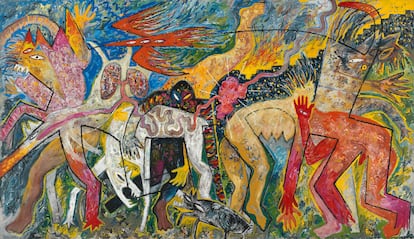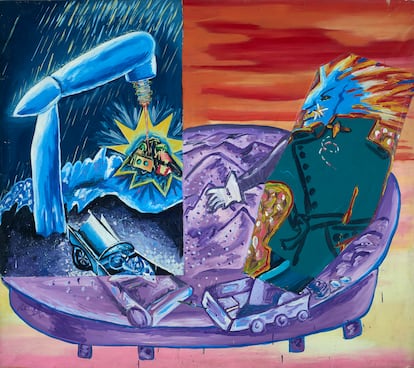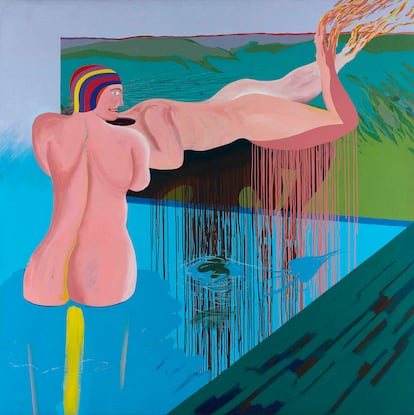The picture is titled Scene. Characters at the exit of a rock concert. Painting by Guillermo Pérez Villalta in 1979, it could be a portrait of the artists who in the immediate postfranchism were given to a figuration in which they narrated their desire for fun and future. The wildest and striking colors served to melt music with poetry or cinema, a cocktail with which they wanted to break with all of the above and approach what their colleagues did in Europe or the United States. Pérez Villalta’s work (Tarifa, Cádiz, 77 years old) is the starting point of one of the most striking exhibitions of summer: Painting released. Young Spanish figuration of the 80swhich until September 14 can be seen at the Villalón Palace of the Thyssen Museum in Malaga. There are 30 works signed by 23 artists provided by institutions and collectors who, in part, also formed an active part of the creative resurgence of those years, as is the case of Pedro Almodóvar.
Lourdes Moreno, artistic director of the Museum and member of the Commissioner team that has organized the exhibition (Bárbara García and Alberto Gil), ventures to identify the artists who appear in the narrative mural of Pérez Villalta, a loan by Reina Sofía. In the upper part of the canvas posa, cigarette in hand, Tesa Arranz (of the Zombies Group). Subject the frame Javier Pérez Thick (Radio Futura). Under the ladder Alaska (Kaka de Luxe). Going down the steps, Miguel Ordóñez (Zombies) is recognized, with Edurne striped shirt (zombies) and his side José Luis Barrionuevo (El Bola). On the right, supported by his guitar is Bernardo Bonezzi (Zombies) and holds Manolo Campoamor (Kaka de Luxe). AGACHADO IS CARLOS GARCÍA BERLANGA (KAKA DE LUXE). In the background, Guillermo Pérez Villalta is self -portrait and at the top of the survey box Herminio Molero (Radio Futura).
The director of the Thyssen says that they wanted to show a heterogeneous mosaic of the figurative painting of the eighties that became a symbol of the new modernity born with the transition and the arrival of democracy: “It was the time of opening of our country. There was a colorful, festive and without political purpose, with themes close to the experiences of the creators.”
Before the color flares of The drunkards (1979/80) by Carlos Alcolea, The alcoholic (1974) by Luis Gordillo or Transvestite (1986) by Juan Antonio Aguirre, Lourdes Moreno recounts that at that stage of transition there was a tremendous explosion of creativity that had its reflection in the plastic arts and also in an nascent cultural ecosystem with new galleries, some of the previous decade – amadis, Buades, Edurne, Vijande, the Spanish machine, Juana de Aizpuru or Lorenzo Solitude.
The 30 works that are exhibited in Malaga do not stop forming a reduced vision of what was that young Spanish figuration. Moreno is aware that there are many more, but his space is limited. “We have chosen,” he argues, “those proposals that were in a similar wave, in terms of a vitalist figuration, with acidic and bright colors, elective affinities have determined the selection, by the way, with a large number of Andalusian artists.”
Barceló in Kassel
In the tour is the work Meat map (1982), a large format canvas with which Miquel Barceló (Felanitx, Balearic Islands, 68 years old) participated in the 1982 Kassel document. He was only 25 years old and such a desire to succeed that his presence in the German city meant the beginning of an unstoppable international career.

Except for some exceptions, the artists of that new figuration have not had great institutional showcases that serve as consecration. Informalisms and new conceptualisms, together with supports such as installation or photography, have left little space. But recovery seems to be underway.
In Madrid, the Guillermo de Osma Gallery dedicates until the end of July an exhibition focused on the first glimpses of the New Figuration Madrid. Centered on the Javier Sapena collection of the seventies, the great collector of this period shows 17 works dated between 1970 and 1975. There are Carlos Alcolea, Chema Cobo, Carlos Franco, Manolo Quejido, Herminio Molero, Rafael Pérez Mínguez and Guillermo Pérez Villalta, among others.
Rediscounts
Also there, as in Malaga, names are missing. Juan Manuel Bonet, a deep connoisseur of this period, says that was a very special moment. “If Guillermo Pérez Villalta, Manolo Quejido, Carlos Franco, Juan Antonio Aguirre or Chema Cobo have ended up being undisputed figures,” says Bonet, “it still is missing, it seems a lie, an exhibition that sets the fleet meteorite that Rafael Pérez Mínguez was Better that came later.

Absent in museums
Manuel Fernández Braso, from the Madrid gallery of the same name, explains that they usually work with three of the artists exhibited in Malaga: Alfonso Albacete, Alfredo Alcaín and Guillermo Pérez Villalta.
In the absence of this generation in the museums, the gallery owner replies that “the reasons why these artists enjoy broad recognition by the public and collectors are the same for which a part of the officiality rejects them. The free and unprejudiced look, the trade of the painter that paints and the open, ambiguous and non -invasive speech connect, entertain and convince many citizens and lovers of art, but do not undermine art ideologies or dogmas ”.
Fernández Braso is convinced that these artists take the public prize while being none by a large part of the officiality, by the Grand Jury. “Fortunately the assessment is changing,” he adds. “The new generations of managers and commissioners are, curiously, who are most claiming the historical importance and validity of their painting today. Exhibition Painting released In Malaga, “he concludes,” it’s just the beginning. In the coming years, the members of the young Spanish figuration of the 80s will be subject to study and exhibition, individually or collectively, of the most important national museums and art centers. ”

